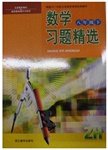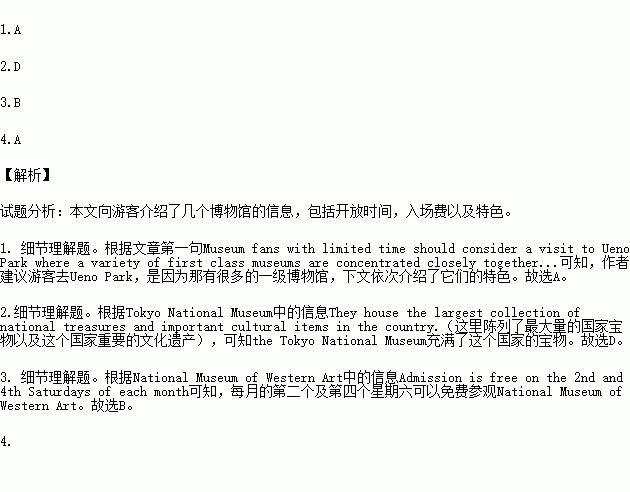题目内容
Museum fans with limited time should consider a visit to Ueno Park where a variety of first class museums are concentrated closely together, including the impressive Tokyo National Museum, the National Museum of Western Art, the Tokyo Metropolitan Art Museum, the National Science Museum and Ueno Zoo along with some smaller museums.
Museums in Tokyo are typically closed on one day of the week (usually Mondays) and during the New Year holidays (typically December 29 to January 4). If the regular weekly closing day falls on a national holiday, most museums will open on the holiday and close the next day instead.
Some museums have extended hours on certain days (typically Fridays), and some offer free entrance to selected exhibitions or on certain days of the month. Most museums allow entry until 30 minutes before closing time.
Tokyo National Museum
Hours: 9:30 to 17:00 (extended hours on some Fridays and weekends)
Closed: Mondays (or following day if Monday is a holiday), New Year holidays
Admission: 600 yen
As the oldest and largest museum in Japan, it is made up of five buildings, each like a separate museum in itself. They house the largest collection of national treasures and important cultural items in the country.
National Museum of Western Art
Hours: 9:30 to 17:30 (until 17:00 in winter, until 20:00 on Fridays)
Closed: Mondays (or following day if Monday is a holiday), Dec 28 to Jan 1
Admission: 420 yen, special exhibitions extra
This museum displays western art, primarily by European artists. There is no permanent gallery and the rotating (轮流的) exhibits are mostly from the museum’s collection. Admission is free on the 2nd and 4th Saturdays of each month.
Tokyo Metropolitan Art Museum
Hours: 9:30 to 17:30 (until 20:00 on Fridays)
Closed: First and third Monday of each month, New Year holidays
Admission: Varies by exhibition
Reopened in April 2012, this museum displays all types of art in its six galleries. There is no permanent collection, but there are multiple temporary exhibitions by various art groups.
National Science Museum
Hours: 9:00 to 17:00 (until 20:00 on Fridays)
Closed: Mondays (or following day if Monday is a holiday), Dec 28 to Jan 1
Admission: 600 yen
This museum covers both science and natural history with hands-on physics and robotics experiments and a 360 degree virtual theater relocated from the Aichi Expo.
1.Visitors are advised to go to Ueno Park mainly because ________.
A. there are many great museums there
B. it has one of the best parks in Japan
C. it is a landmark building in Tokyo
D. it is free of charge throughout the year
2.We can learn from the text that the Tokyo National Museum ________.
A. is the oldest and largest museum in Asia
B. has the largest collection of artwork in Japan
C. has a 360 degree virtual theater
D. is full of Japan’s national treasures
3.According to the text, you can visit the ________ for free on certain days.
A. Tokyo National Museum
B. National Museum of Western Art
C. Tokyo Metropolitan Art Museum
D. National Science Museum
4.The passage is most likely taken from ________.
A. a tourist guide
B. a geographic report
C. a travel journal
D. a science textbook
 习题精选系列答案
习题精选系列答案A Language Programme for Teenagers
Welcome to Teenagers Abroad! We invite you to join us on an amazing journey of language learning.
Our Courses
Regardless of your choice of course, you’ll develop your language ability both quickly and effectively. Our Standard Course guarantees a significant increase in your confidence in a foreign language, with focused teaching in all 4 skill areas—speaking, listening, reading and writing. Our Intensive Course builds on our Standard Course, with 10 additional lessons per week, guaranteeing the fastest possible language learning (see table below).
Course Type | Days | Number of Lesson | Course Timetable |
Standard Course | Mon-Fri | 20 lessons | 9:00-12:30 |
Intensive Course | Mon-Fri | 20 lessons | 9:00-12:30 |
10 lessons | 13:00-14:30 |
Evaluation
Students are placed into classes according to their current language skills. The majority of them take on online language test before starting their programme. However, if this is not available, students sit the exam on the first Monday of their course. Learning materials are provided to students throughout their course, and there will never be more than 15 participants in each class.
Arrivals and Transfer
Our programme offers the full package—students are taken good care of from the start through to the very end. They are collected from the airport upon arrival and brought to their accommodation in comfort. We require the student’s full details at least 4 weeks in advance.
Meals/Allergies(过敏)/Special Dietary Requirements
Students are provided with breakfast, dinner and either a cooked or packed lunch(which consists of a sandwich, a drink and a dessert). Snacks outside of mealtimes may be purchased by the student individually.
We ask that you let us know of any allergies or dietary requirements as well as information about any medicines you take. Depending on the type of allergies and/ or dietary requirements, an extra charge may be made for providing special food.
1.How does Intensive Course differ from Standard Course?
A. It is less effective.
B. It focuses on speaking.
C. It includes extra lessons.
D. It give you confidence
2.Before starting their programme, students are expected to ________.
A. take a language test
B. have an online interview
C. prepare learning materials
D. report their language levels
3.With the full package, the programme organizer is supposed to ________.
A. inform students of their full flight details
B. look after students throughout the programme
C. offer students free sightseeing trips
D. collect students’ luggage in advance

